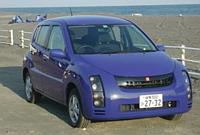Toyota’s latest super-mini not only takes you out to dinner, but helps you decide where to go.
Justin Gardner writing for Japan Today reported that The Will is the car that ’80s engineers thought we’d all be driving in the 21st century. But ever since Toyota launched the “alternatively designed” vehicles in 2000, they’ve never mounted a serious challenge to more mainstream brands. The first Will, known as the Vi, certainly caused a stir with its distinctively raked back window and corrugated body panels, but it only attracted buyers who thought form was more important than function. 2001’s version, the Batmobile-like Vs, fared a little better. Late last year, though, Will surprised everyone—not least Toyota themselves—by selling four times as many of the new Cypha hatchbacks as the most optimistic projections had forecast, and taking a large chunk of the Toyota Vitz’s market share for itself.
Ironically, the Cypha is basically a Vitz in rotund sheep’s clothing, as beneath the bulbous body lie an identical engine, drivetrain and sub-frame. But the Cypha’s exterior styling—from the vertically aligned headlights to the rear window-encompassed tail lights—is nothing if not unique. The only clue to its origins lies in the window line of the doors, which is unchanged from the humble Vitz.
Out and about Like its siblings, the Cypha offers astounding fuel economy for a car of this class: claiming 18km per liter in city driving for the 1.3-liter version. In our own four-day test of pedal-to-the-metal mountain and highway driving, the 1.5 still managed to return a most impressive 11km to the liter. The Cypha is also the 26th Toyota to earn a Japan Ultra Low Emission Vehicle certification, meaning that it produces 75 percent fewer harmful emissions than required by year 2000 standards and qualifies for a 50 percent reduction in automobile tax under the government’s upcoming Green Taxation System.
Such eco-friendliness has come at the expense of performance, however. In the back country, the engine made heavy work of lugging the relatively light one-ton hatchback around switchbacks, and it gave no pretense of sportiness when leaving traffic lights. Nonetheless, the motor is content to hum along at the speed limit of Japan’s highways with minimal fuss. This is true even on long climbs, although the driver must be wary of unnecessary and intrusive downshifts from the automatic box—there is no manual version.
We couldn’t fault the test car’s handling and ride. The wheel-in-each-corner design, coupled with a stiff, well-balanced chassis and standard four wheel drive, make for confidence-inspiring control and grip, with minimal body roll. One can only imagine how much fun this car would be with a more powerful lump up front (Toyota engineers, are you reading?).
Inside, the driver’s experience is less pleasant. While undeniably cool and futuristic, the Will’s acres of black plastic and steering wheel are rough and unpleasant to the touch, and scuff easily. Worse, dashboard panels that conceal airbags and the like have ugly gaps around them, which shake and rattle. Was this car really built in a Toyota factory?
Where the finish may be below par, the overall design is as superb as it is funky; it’s not hard to see where the designers’ priorities lay. Air conditioning controls are easily within reach of both driver and passenger, and they’re intuitive and round. The entire center console is curved, too, as are the door handles and the motifs on the nicely contoured seats. The rear of the car has also been rounded off, with extended wheel arches protruding beyond the tailgate—although Toyota missed a chance here to expand the Vitz’s pitifully small trunk.
Mobile communication The Cypha’s trump card, though, is its built-in terminal that allows users to access Toyota’s proprietary “G-Book” network. Similar to NTT DoCoMo’s i-mode service, G-Book provides information about local restaurants, cinemas and hotels. Park in an unfamiliar town (the touch-screen doesn’t work when the car is moving), tell G-Book that you’re hungry, and the service will not only show you a choice of restaurants within a proximity that you specify, but it’ll let you know about any special offers they have. And once you’ve chosen where to have your meal, the navigator takes over and guides you to your dinner.
The interface also accepts SD memory cards, allowing you to upload pictures from compatible digital cameras and to play MP3s from your Napster collection, while also fetching detailed maps from the new E-Tower terminals found in convenience stores. G-Book can also read news and weather to commuters at predetermined times, as well as reading email as it arrives in the terminal’s inbox.
Basically, G-Book appears to do everything that a modern mobile phone can do—in Japanese, as there’s not yet an English version available—but a little bit better and more easily. For Japan’s keitai generation, G-Book-equipped cars are guaranteed to be a hit. For those of us who are a little more analog in our thinking, well, we may be better off sticking to our maps and magazines.



